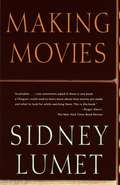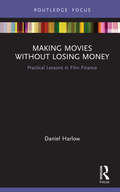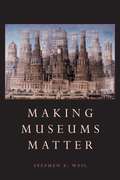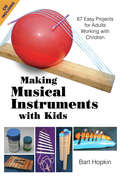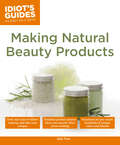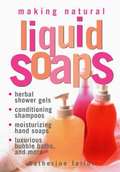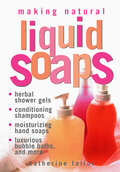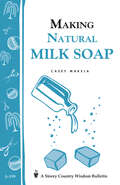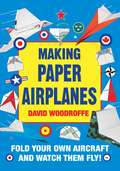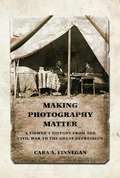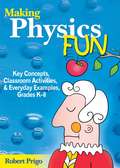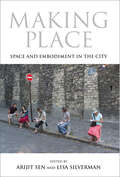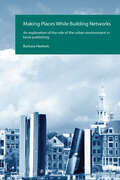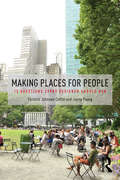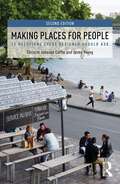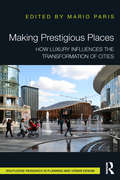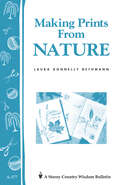- Table View
- List View
Making Movies
by Sidney LumetSidney Lumet writes about his experiences in the movie industry and the difficulties faced in making films.
Making Movies Without Losing Money: Practical Lessons in Film Finance
by Daniel HarlowThis book is about the practical realities of the film market today and how to make a film while minimizing financial risk. Film is a risky investment and securing that investment is a huge challenge. The best way to get investors is to do everything possible to make the film without losing money. Featuring interviews with film industry veterans - sales agents, producers, distributors, directors, film investors, film authors and accountants - Daniel Harlow explores some of the biggest obstacles to making a commercially successful film and offers best practice advice on making a good film, that will also be a commercial success. The book explores key topics such as smart financing, casting to add value, understanding the film supply chain, the importance of genre, picking the right producer, negotiating pre-sales and much more. By learning how to break even, this book provides invaluable insight into the film industry that will help filmmakers build a real, continuing career. A vital resource for filmmakers serious about sustaining a career in the 21st century film industry.
Making Murals: A practical handbook for wall painting and mural art to enhance your home
by Clara Wilkinson Mary WestThis practical guide to mural painting explains all the key techniques and design styles you need so that you can get creative in your own home and start 'unsaming' your walls. Murals are a fantastic way to breathe new life into an interior or exterior space. Mural painting is perfect for creating a particular theme in a room, livening up a boring corner of your home and personalising a child's bedroom with their favourite characters. It can also be used to spruce up corridors, hallways and stairwells and other areas of our homes which often get forgotten about. This practical guide to mural painting explains all the essential techniques for getting started including what kind of paints and brushes to use, how to work on various wall surfaces and how to prepare the surface area before painting in order to get the best results. Authors Clara Wilkinson and Mary West, outline the practicalities you need to consider when you are planning a mural such as how much light the area receives and how will it fit in the desired space. They also look at where to find inspiration sources, how to use colour in your work and how different styles of painting suit certain locations. One of the most challenging elements to creating a mural is how to transfer your ideas from paper onto a wall or ceiling and how to scale up' the design. The authors explore various techniques for transferring mural designs including the traditional grid method and their own innovative doodle grid' method. Murals offer an exciting opportunity to try out different styles of painting: abstract graphic, painterly and linear are all styles that are looked at in this collection. These painting techniques are explored using step-by-step photography and there is advice on how to combine different techniques to create stunning results. The authors take us on a tour of some of their most exciting wall art and murals and explain, using step-by-step instructions and photography, how you can achieve similar results by either using their design templates or learning how to create your own. Each of these projects is based on a particular theme including Chinoisserie, graphic botanical, celestial, tropical jungle, linear abstract, florals and a painterly abstract design. Just choose your favourite and get started!
Making Museums Matter
by Stephen WeilIn this volume of 29 essays, Weil's overarching concern is that museums be able to "earn their keep"--that they make themselves matter--in an environment of potentially shrinking resources. Also included in this collection are reflections on the special qualities of art museums, an investigation into the relationship of current copyright law to the visual arts, a detailed consideration of how the museums and legal system of the United States have coped with the problem of Nazi-era art, and a series of delightfully provocative training exercises for those anticipating entry into the museum field.From the Trade Paperback edition.
Making Music: From Tambourines to Rainsticks to Dandelion Trumpets, Walnut Castanets to Shepherd's Pipes to an Abundance of Homemade Drums, Here Is a Joyful, Quirky Assortment of Good Sounds from Found Objects
by John Langstaff Ann Sayre WisemanTune up a milk carton guitar and get ready for a kitchen concerto in the key of utensils major! Ann Sayre Wiseman and John Langstaff offer dozens of ideas that encourage children to unlock their musical creativity using everyday objects. Kids will be inspired as they turn a shower hose into a trumpet or pair zippers and Velcro to make their own percussion ensemble. With ideas for creating and playing more than 70 basic rhythm, string, wind, and keyboard instruments, the musical possibilities are endless.
Making Musical Instruments with Kids: 67 Easy Projects for Adults Working with Children
by Bart HopkinWritten for adults, this hands-on guide demonstrates how to make easy musical instruments with children. Detailed instructions are included for making more than 60 unique instruments that are suitable for children as young as five years. Serving as a resource in the classroom or home, this manual is extensively illustrated with drawings and photographs along with an audio sample of the instruments in lively solo and ensemble pieces.
Making Natural Beauty Products: Over 250 Easy-to-Follow Makeup and Skincare Recipes (Idiot's Guides)
by Sally TrewThis highly visual guide teaches you how to make skincare, makeup, and many more personal-care and beauty products using natural ingredients. For both men and women, step-by-step, full-color photos guide you through basic beauty recipes, followed by more than 250 color and blend variations. Readers with sensitive skin, as well as those who want to save money and avoid harmful chemicals, will find everything you need to get started making your own luxurious, natural beauty products. Content includes: 250 recipes with beautiful, full-color photography. Step-by-step guidance through the foundational recipes, showing tools, ingredients, and techniques. Shopping lists and suppliers for natural ingredients, including essential oils, butters, clays, minerals, colors, and fragrances. Basics and recipes for creating mineral foundations, color correctors, and concealers. Formulas for skin-healing balms, creams, and oils. Products for men, including shaving products, powders, moisturizers, facial care, foot care, and massage oil.
Making Natural Liquid Soaps
by Catherine FailorUsing a simple double-boiler technique, readers will make elegant and soothing liquid soaps. Dozens of recipes using oils, herbs, and other natural ingredients to create hand soaps, shower gels, bubble baths, conditioning shampoos and even baby and pet shampoos.
Making Natural Liquid Soaps: Herbal Shower Gels, Conditioning Shampoos, Moisturizing Hand Soaps, Luxurious Bubble Baths, and more
by Catherine FailorMake our own liquid soaps and body products right in your kitchen. Catherine Failor shows you how to use her simple double-boiler technique to create luxurious shower gels, revitalizing shampoos, energizing body scrubs, and much more. Step-by-step instructions teach you how to turn basic ingredients like cocoa butter, lanolin, and jojoba into sweet-smelling liquid soaps. You’ll soon be experimenting with your favorite oils and additives as you craft custom-made products that are kind to your nose and gentle on your skin.
Making Natural Milk Soap: Storey's Country Wisdom Bulletin A-199
by Casey MakelaSince 1973, Storey's Country Wisdom Bulletins have offered practical, hands-on instructions designed to help readers master dozens of country living skills quickly and easily. There are now more than 170 titles in this series, and their remarkable popularity reflects the common desire of country and city dwellers alike to cultivate personal independence in everyday life.
Making Pagans: Theatrical Practice and Comparative Religion in Early Modern England (Published in cooperation with the Folger Shakespeare Library)
by John KuhnHow early modern theatrical practice helped construct the category of “pagan” as a tool of European self-definition and colonial ambitionIn Making Pagans, John Kuhn argues that drama played a powerful role in the articulation of religious difference in the seventeenth century. Tracing connections between the history of stagecraft and ethnological disciplines such as ethnography, antiquarianism, and early comparative religious writing, Kuhn shows how early modern repertory systems that leaned heavily on thrift and reuse produced an enduring theatrical vocabulary for understanding religious difference through the representation of paganism—a key term in the new taxonomy of world religions emerging at this time, and a frequent subject and motif in English drama of the era.Combining properties such as triumphal chariots, trick altars, and moving statues with music, special effects, and other elements, the spectacular set-pieces that were mostly developed for plays set in antiquity, depicting England’s pre-Christian past, were frequently repurposed in new plays, in representations of Native Americans and Africans in colonial contact zones. Kuhn argues that the recycling of these set-pieces encouraged audiences to process new cultural sites through the lens of old performance tropes, and helped produce fictitious, quasi-ethnographic knowledge for spectators, generating the idea of a homogeneous, trans-historical, trans-geographical “paganism.” Examining the common scenes of pagan ritual that filled England's seventeenth-century stages—magical conjurations, oracular prophecies, barbaric triumphal parades, and group suicides—Kuhn traces these tropes across dozens of plays, from a range of authors including Ben Jonson, Christopher Marlowe, John Dryden, and Philip Massinger.Drawing together theater history, Atlantic studies, and the history of comparative religion, Making Pagans reconceptualizes the material and iterative practices of the theater as central to the construction of radical religious difference in early modernity and of the category of paganism as a tool of European self-definition and colonial ambition.
Making Paper Airplanes: Fold Your Own Aircraft and Watch Them Fly!
by David WoodroffeChoose from ninety-one different models and build and fly your very own paper airplane. Now, any kid can turn a stack of paper into his or her own private air force! Making Paper Airplanes is your complete reference packed with colorful diagrams, graphics, and instructions, featuring ninety-one gravity-defying paper aircraft that really fly. From origami fighter jets to tin foil helicopters and paper Spitfires, you and your child will learn hundreds of different ways to build successful flying devices from paper. Each model includes customized graphics so your aircraft will look the part as it sails through the air. Tear out, fold, and fly models such as: Stealth BomberKestrel FighterDragon Desk KiteFirefly Space ShuttleSwallow GliderFlashdance Stunt FlyerGolden Flame Racing PlaneSupersonic TransportAnd More! All of these fantastic flying machines have been built and tested by the author to ensure that, with little more than a few folds and a couple of snips, your new creation can be airborne. Whether you are spending a summer's day outdoors or a winter's day indoors, Making Paper Airplanes will deliver hours of crafts, flights, and fun.
Making People-Friendly Towns: Improving the Public Environment in Towns and Cities
by Francis TibbaldsMaking People-Friendly Towns explores the way our towns and cities, particularly their central areas, look and feel to all their users and discusses their design, maintenance and management. Francis Tibbalds provides a new philosophical approach to the problem, suggesting that places as a whole matter much more than the individual components that make up the urban environment such as buildings, roads and parks. This informative book suggests the way forward for professionals, decision-makers and all those who care about the future of our urban environment and points the reader in the direction of a wealth of living examples of successful town planning.
Making Photographs: Planning, Developing and Creating Original Photography (Basics Creative Photography)
by Mike SimmonsThis book explores a range of photographic practices, including landscape and portraiture, still life and abstract, and considers techniques such as, directorial photography, photomontage and camera-less photography. With case studies and practical exercises, the reader is introduced to a structured way of developing creative solutions to the work they want to make, fusing personal ideas with knowledge, compositional elements and practical skills. The book enables informed choices to be made about the reader's personal growth as a photographer, contributing to the creation of original photographic work that is informed, meaningful and relevant. Additional reading and resources, on historical and contemporary practices, ideas and techniques, are suggested in each chapter to inspire further enquiry and experimentation.
Making Photography Matter: A Viewer's History from the Civil War to the Great Depression
by Cara A. FinneganPhotography became a dominant medium in cultural life starting in the late nineteenth century. As it happened, viewers increasingly used their reactions to photographs to comment on and debate public issues as vital as war, national identity, and citizenship. Cara A. Finnegan analyzes a wealth of newspaper and magazine articles, letters to the editor, trial testimony, books, and speeches produced by viewers in response to specific photos they encountered in public. From the portrait of a young Lincoln to images of child laborers and Depression-era hardship, Finnegan treats the photograph as a locus for viewer engagement and constructs a history of photography's viewers that shows how Americans used words about images to participate in the politics of their day. As she shows, encounters with photography helped viewers negotiate the emergent anxieties and crises of U.S. public life through not only persuasion but action, as well.
Making Physics Fun: Key Concepts, Classroom Activities, and Everyday Examples, Grades K?8
by Robert PrigoBoost student interest and understanding in the physical sciences!Teaching physical science in the elementary and middle grades can be challenging for busy teachers faced with growing demands and limited resources. Robert Prigo provides fun and engaging activities using safe, available materials that educators can easily incorporate into lesson plans. Extensive examples, sample inquiry questions, and ideas for initiating units are readily available for teachers to pick and choose from to meet student needs.The result of more than two decades of professional development work with hundreds of teachers and administrators, this resource addresses specific areas of physical science, including motion and force, waves and sound, light and electromagnetic waves, and more. Dozens of activities demonstrating physics in action help students of all ages relate physics principles to their everyday experiences.This practitioner-friendly resource helps teachers: Address the "big ideas" in K-8 science education Promote student understanding with ready-to-use learning experiences Use hands-on activities to help students make larger, real-world connections Assemble classroom learning centers to facilitate deeper understanding of basic physics principlesWith conceptual summaries to support teachers' proficiency and understanding of the content, this guidebook is ideal for bringing physics to life for students in the classroom and in their lives!
Making Place: Space And Embodiment In The City
by Arijit Sen Lisa SilvermanSpace and place have become central to analysis of culture and history in the humanities and social sciences. Making Place examines how people engage the material and social worlds of the urban environment via the rhythms of everyday life and how bodily responses are implicated in the making and experiencing of place. The contributors introduce the concept of spatial ethnography, a new methodological approach that incorporates both material and abstract perspectives in the study of people and place, and encourages consideration of the various levels--from the personal to the planetary--at which spatial change occurs. The book's case studies come from Costa Rica, Colombia, India, Austria, Italy, the United Kingdom, and the United States.
Making Places While Building Networks: An exploration of the role of the urban environment in book publishing (Pallas Proefschriften)
by Barbara HeebelsThe Amsterdam ring of canals is a much beloved location for Dutch book publishers. An exposition of the meaning of this urban environment for publishers adds to the existing knowledge on book publishers and their business locations. It also contributes to our understanding of the role of urban place in cultural production by looking at cultural production from a relatively unexplored angle – that of the cultural intermediary – and by conceptualizing place as a dynamic concept. Publishers function as cultural intermediaries by bringing together the creation of cultural value and the selling of cultural products. An exploration of the meaning of urban place for cultural intermediaries in building reputation and trust in their personal networks with authors, booksellers, colleagues and the press, shows that place is more than geographical proximity and is not a static condition for knowledge spill-overs: it is a process, one that is interdependent on social networks.
Making Places for People: 12 Questions Every Designer Should Ask
by Jenny Young Christie Johnson Coffin** Honorable Mention at the 2019 ERDA Great Places Awards ** Making Places for People explores twelve social questions in environmental design. Authors Christie Johnson Coffin and Jenny Young bring perspectives from practice and teaching to challenge assumptions about how places meet human needs. The book reveals deeper complexities in addressing basic questions, such as: What is the story of this place? What logic orders it? How big is it? How sustainable is it? Providing an overview of a growing body of knowledge about people and places, Making Places for People stimulates curiosity and further discussion. The authors argue that critical understanding of the relationships between people and their built environments can inspire designs that better contribute to health, human performance, and social equity—bringing meaning and delight to people’s lives.
Making Places for People: 12 Questions Every Designer Should Ask
by Jenny Young Christie Johnson CoffinMaking Places for People explores 12 social questions crucial to environmental design. Authors Christie Johnson Coffin and Jenny Young bring perspectives from practice and teaching to challenge assumptions about how places meet human needs. In this expanded second edition, the authors continue to explore the complexities of basic questions, such as: What is the story of this place? What logic orders it? How big is it? How sustainable is it? They consider the impact on making places of pandemic, climate change, human migration, and contemporary discussions of diversity, equity, and justice. Short, approachable, easy-to-read chapters, illustrated with updated examples of projects from around the world, bring together theory, methodology and key research findings. Understanding experienced and research-based connections between people and built form can inspire designs that make places of meaning and delight. This second edition will be essential reading for design students and professionals.
Making Prestigious Places: How Luxury Influences the Transformation of Cities
by Mario ParisMaking Prestigious Places investigates the spatial dimension of luxury, both as a sector involving activities, operators and investments, and as a system of values acting as a catalyst for recent urban transformations. Luxury shares a well-established connection to the city, as a place of production, consumption and self-representation, and continues to grow despite economic difficulties. This edited collection includes case studies from Europe, North and South America, Asia and the Middle East to create a dialogue around these developments and the challenges presented, such as the tension between the idea of prestige and current values in urban planning, the discussion between academic reflections and operational practices, and how these interact with the long-term economic and social dynamic of the city. With rich analysis and a preface written by Patsy Healey, this book will be an important addition to the discourse on luxury for urban planners and researchers.
Making Prints from Nature: Storey's Country Wisdom Bulletin A-177
by Laura Donnelly BethmannSince 1973, Storey's Country Wisdom Bulletins have offered practical, hands-on instructions designed to help readers master dozens of country living skills quickly and easily. There are now more than 170 titles in this series, and their remarkable popularity reflects the common desire of country and city dwellers alike to cultivate personal independence in everyday life.
Making Progress in Writing
by Eve BearneChildren's achievements in writing lag behind their achievements in reading, speaking and listening. National tests are beginning to expose this gap and inevitably, it is raising concerns. The issue is not without controversy but regardless of the politics of the situation, national progress in children's writing is both needed and possible.This new book from Eve Bearne makes a valuable contribution towards helping teachers close this gap. Uniquely, it follows the structure of the National Literacy Strategy, whilst examining key areas such as bridging KS2 and KS3 writing, and writing skills beyond the Literacy Hour. Such a structure makes the book incredibly practical and easy to use, providing essential information for both practitioners and academics.
Making Puppets Come Alive: How to Learn and Teach Hand Puppetry
by Larry Engler Carol FijanUnlike other performing arts, puppetry is perhaps the only art form in which directing, acting, writing, designing, sculpture, and choreography are combined. In effect, the performer is creating an artistic entertainment that will appeal to audiences of all ages -- in homes, in theaters, and in classrooms.This lucid, easy-to-follow book was specifically conceived to teach beginners how to bring a hand puppet to life and how, with practice, to develop the skills needed to mount an amateur puppet show -- complete with staging, costumes, and special effects. Award-winning puppeteers Larry Engler and Carol Fijan provide ingenious finger, wrist, and arm exercises that are crucial for creating a full working range of puppet motions and emotions. They also cover the elements of good puppet theatrical technique: speech, voice use, and synchronization; stage deportment and interactions; improvisation, dramatic conflict, role characterization, and more.Every detail is clearly explained and beautifully illustrated with photographs, specific chapters being devoted to the use of props, puppet voices and movements, the construction of simple stages and lighting effects, and much more. A splendid addition to the literature on this subject, Making Puppets Come Alive is "the best book on hand puppetry we've seen." -- The Whole Kids Catalog.
Making Quilts with Kathy Doughty of Material Obsession: 21 Authentic Projects
by Kathy Doughty“Quilters will learn to push the limits of color and print combination with a flair from ‘down under’ . . . surprisingly pleasing results” (American Quilt Retailer).Stating that each quilt is but a starting point for a new quilt, this joyful book Making Quilts with Kathy Doughty of Material Obsession showcases 21 patterns inspired by the intense colors of Australia and invites you to recreate them in your own voice. Author Kathy Doughty encourages you to discover what appeals to you in each quilt. To help you define your own style, each quilt pattern is outlined by three exploratory tips regarding concept, technique, and fabric choices. Simply follow the easy guidelines and let your instincts make your choices.21 inspiring projects grouped in three categories: Optical Illusions, Tradition with a Twist, Folk Art InspirationPatterns are designed in a variety of styles to appeal to any sewist no matter what her tasteLearn how to make good decisions relating to color value and contrast for balanced impact
